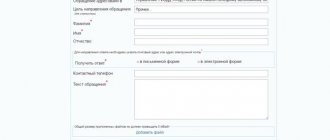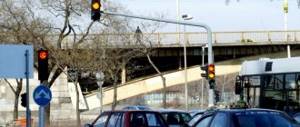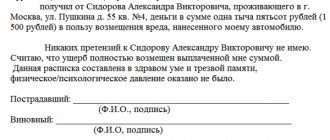Characteristics of explanatory
Any documentation used when registering an accident is strictly regulated. An explanatory note is a kind of report about the accident that occurred, which describes in detail the following:
- The number of participants in the incident (not only drivers, but also passengers are taken into account);
- Possible witnesses (their full name, telephone number);
- Data from the VU and PTS;
- Circumstances under which a collision occurred between two or more vehicles (this includes: weather conditions, road condition, lighting, speed and trajectory of the vehicle, etc.);
- Contact details of the culprit of the accident and the injured party;
- Information about the damaged cars (make, color, license plate, technical condition, etc.);
- Address where the car accident occurred (city, street, approximate coordinates by house numbering).
This document also indicates which of the passengers was sitting in the back, who was in front, and whether the driver was wearing a seat belt at the time of driving the vehicle.
Advice! But before you start filling out an explanatory note in case of an accident according to a single model, the car owner must decide in advance which side in the conflict he takes (the initiator or the victim). After all, the content of the form will directly depend on this.
Why is it compiled?
An explanatory certificate is a written statement of the point of view of each of the participants in a traffic accident, and therefore in the future it can be used by State Traffic Inspectorate employees to determine the culprit of the accident. Also, this document is sometimes required by insurance company employees if their representative was not at the scene of the accident. After all, who will be recognized as the initiator of the conflict directly determines in whose favor compensation for damage will occur.
If one of the participants in the car accident refuses to fill out an explanation for the accident, then the traffic police, with almost one hundred percent probability, will recognize him as a violator. A person can prove the opposite only if there is a photo/video recording of the incident or witnesses who are ready to confirm the status of the victim.
The process of filling out an explanatory note by participants in an accident
Drivers receive explanatory forms from traffic police officers. This form is sometimes filled out with one’s own hand, and sometimes - by the inspector according to the driver. Remember that you will need your passport information to complete the explanation. It is better to remember them by heart or have a note with them: number, series, place of registration and who/when the passport was issued. If the document is filled out in your words, and not by you personally, then you need to read it very carefully before signing.
It is important to be careful about the formatting of your explanation. It cannot be evidence of the driver's guilt. But if you and the other participant in the accident do not come to an agreement, then there will be a second and third analysis, with the participation of witnesses. Perhaps everything will go to court. And it can be difficult to challenge the information that the participant in the accident himself presented in hot pursuit.
Filling rules
We mentioned earlier that before drawing up an explanatory note, the driver should decide on the side he takes in a traffic conflict.
After all, the completed forms for the initiator of an accident and the injured motorist will be noticeably different. To better understand the difference between the culprit of the accident and the victim, we will look at three different examples of filling out an explanatory letter.
For the culprit
Being one hundred percent sure that he was wrong in a traffic accident, the citizen needs to write the following in the explanatory document:
“I, Ivanov Stepan Aleksandrovich, driving a VAZ-2109 car (registration number P877PA98) drove onto the roadway from the yard without giving priority to the Mercedes S200 car. Due to bad weather conditions, I was unable to see the mentioned traffic participant in time. I fully admit my guilt in the incident.”
It is important to know! As you can see, the presented explanatory report about the accident contains a minimum of information, since one of the participants in the conflict voluntarily took the side of the initiator of the accident. But in practice, a similar lack of information about witnesses to a collision occurs quite often. After all, few people want to spend their time analyzing the situation at the traffic police and visiting the State Traffic Inspectorate every day.
For the innocent
If the motorist is one hundred percent sure of his innocence in the accident, then he will have to enter more extensive information into the explanatory note. And it will look something like this:
“I, Petrov Ivan Sergeevich, moving along the street. Trubnikov 16 A, in a VAZ-2110 car (state number G875RA98) with a passenger Andrey Pavlovich Sidorov, while wearing a seat belt, collided with a Moskvich car, which was reversing along the left side of the road. Weather conditions allowed the second participant in the traffic conflict to see my car in advance. There is dashcam video of the accident. I do not consider myself guilty in this situation, and I refuse to testify in my favor, in accordance with Art. 51 of the Constitution of the Russian Federation."
Despite the fact that the law requires participants in a traffic conflict to provide a more detailed explanation of the accident, car owners are not required to enter all the data. In the absence of some information, you can refer to absolutely any reason (the culprit tried to escape from the scene of the accident, and therefore his license plate number could not be seen, or the driver was focused on driving through a dangerous area, which is why he did not notice the details of what happened, etc.).
For those unsure of the situation
As practice shows, the parties most often cannot find out among themselves exactly who is to blame for an accident and who is not. And in this case, we are not talking about a complete denial of guilt by both drivers, but about the uncertainty that arises among the participants in the accident due to the stress they received. In such circumstances, you need to act as follows:
- The driver's full name, make and license plate number of his car are included in the header of the explanatory sheet;
- The fact of a collision is indicated (it is not worth describing the details, as this may work against you);
- The conclusion mentions that the motorist does not consider himself guilty (even if this is not entirely true).
Also, it is imperative to exclude from the explanatory note all possible eyewitnesses of the car accident, since their information may differ from the true picture of the accident. As evidence when making a compensation payment under compulsory motor liability insurance, lawyers recommend using only the recording from the video recorder (if available).
Police officers ask you to write an explanatory note that would suit them
Good afternoon Please tell me about this issue. 2 weeks ago we were returning home after work with our husband; the husband was driving. A small child about 4-5 years old ran out onto the road, the husband got out of the car and scolded the child not to run out onto the road, as he might get hit by a car. The child was running along the street without adult supervision. The next day, traffic police officers arrived and demanded to provide an explanatory statement regarding the fact of beating the child. The child apparently came home and said that he had been beaten. An explanatory note was provided, a certain amount of time passed and the investigator called and asked to write an explanatory note also regarding the fact of beating the child. The husband said that he did not beat the child, he simply scolded him, because he was afraid that the child might get hit by a car. The investigator refuses to accept the explanatory note, citing the fact that in the explanatory note the spouse must admit that he beat the child. On what basis does the investigator refuse to accept the explanatory note and on what basis does he dictate what my husband should write? The investigator says that if my husband does not write as he should, a criminal case will be opened against my husband. What to do? The problem is that in our small town everyone knows each other, the father of this child himself works in the traffic police.
What to do if the driver is in a cloudy state
When involved in a traffic accident, almost all motorists experience severe stress. And sometimes this state prevails over a person so much that he can hardly express his thoughts, not to mention write an explanatory report on an accident. But such circumstances are never taken into account in court. Therefore, while in shock from the accident, it is strictly not recommended for the driver to describe what happened on paper or put signatures on a ready-made form.
If the victim cannot avoid filling out an explanatory document, then when drawing it up it is necessary to indicate as little information as possible. For example:
“I, Sergeev Vitaly Konstantinovich, got into an accident. I am not able to describe the situation in detail, because at the moment I am under severe stress. I will give all comments regarding what happened later, when applying for MTPL insurance or in court.”
Advice! It is categorically not worth mentioning either witnesses or participants in the accident (except yourself). Only after the driver recovers from the shock can he contact the traffic police to draw up the correct sample of an explanatory letter to the traffic police in case of an accident, indicating all the necessary data.
Sample explanation for an accident: detailed plan
An explanatory note in case of an accident is written in free form, like an essay. But it is necessary to reflect a number of facts, namely:
- Date and time of the accident.
- License number and make of your own car: “I, driving /license number, make/.”
- The number of passengers in your vehicle.
- The direction of movement of your car, street, etc.: “moving along / highway, street, motorway / towards ... from the side...”.
- The lane you were driving in and your speed.
- Models and brands of other vehicles involved in the accident.
- Various circumstances of the accident.
- Information about victims and witnesses of road accidents. If there are no victims and/or witnesses, this should also be indicated.
- Do you insist on a medical examination of the second driver involved in the accident?
Legal consultation
Get qualified help right now! Our lawyers will advise you on any issues out of turn!
To get a consultation
If your guilt is not obvious, you consider yourself innocent of the incident, then you must definitely indicate this in something like this: “I do not agree with the guilt in the accident.”
At the end of the explanatory note it is indicated that it was written in one’s own hand. The date and signature are affixed, and the corresponding lines indicate contact information (mobile phone number), place of work and registration, place of actual residence.
What not to write about in an explanatory note
We learned how to correctly draw up a note on behalf of the culprit and the victim, as well as what information a sample explanatory note in an accident should contain. Now is the time to consider that part of the information that clearly does not belong in the document. This includes:
- Sincere repentance for the incident (by accepting the blame in full, a person risks paying not only material damage to the victims, but also moral damage caused to third parties);
- Attempts to attribute the accident to weather conditions (in court, although such circumstances are taken into account, they do not relieve responsibility from the guilty driver, and do not even mitigate the punishment imposed on him);
- Information about the last time he took alcohol (if a motorist mentions that he drank yesterday, but at the time of the accident he felt adequate, then such an explanation may turn against him during the trial);
- Information about the number of years of accident-free driving (all past achievements of a citizen are not taken into account by traffic police officers for a specific offense, and therefore there is no point in describing them).
Attention! All of the above data will either have no meaning in court, or will work against the applicant. This means that it is clearly not worth indicating them in the explanatory notice.
Legal significance of explanatory notes
An explanatory note has important legal significance as an integral part of the procedure for bringing an employee to disciplinary liability. According to Article 193 of the Labor Code of the Russian Federation, before bringing an employee to disciplinary liability, the employer must request a written explanation
A documented explanation, first of all, helps establish the truth, reflects the employee’s view of what happened, his attitude to the offense and its consequences.
On the other hand, if an employee is found guilty of committing an offense, he has the opportunity to repent of his actions and assure the employer of the accidental and unintentional nature of his offense. If the employee believes that he has not committed any misconduct, he has the opportunity to explain his own reasons and provide the necessary evidence.
It happens that a thorough analysis of the contents of the explanatory note helps the employer not only not to punish the employee, but also to determine the real culprit of the violation. Consequently, an explanatory document contributes to an objective assessment by the employer of the current situation and allows one to fairly impose (or cancel) a disciplinary measure against a specific employee.
Important: in order for the employer to receive a document that is valuable from a legal point of view, it is necessary that in the explanatory note the employee sets out in detail all the circumstances of his action (or inaction) and indicates:
- Does he consider his behavior illegal, i.e. violating the performance of labor duties, with the presentation of arguments confirming their own position;
- does he admit his guilt?
- What was the cause of this offense?
- How does the employee assess the negative consequences that the employer experienced in connection with this offense?
- Does the employee consider his possible disciplinary action fair?
It should be remembered that an employee can refuse to write an explanatory note without consequences in the form of legal liability being applied to him for such a refusal.
Important Details
The form for an explanatory note in case of an accident can be downloaded on the Internet or asked for it from traffic police inspectors if they are at the scene of the accident. But in general, it is advisable to always carry such a document with you in your car, in case you get into a traffic conflict. When filling out the mentioned paper, in addition to generally accepted information, the driver must indicate some details of the incident, such as:
- The nature of the lighting (presence of street lights, type of headlights of an oncoming car, etc.);
- Factors limiting the visibility of the car owner (fog, heavy rain, snow, etc.);
- Condition of the road surface (presence of holes, obstacles or slippery areas).
But this information should be mentioned in passing, without attributing the entire blame for the accident to it. After all, in this case, you risk not receiving an insurance payment and car repairs will fall entirely on your shoulders.
We learned how to fill out an explanation form for an accident, and what data it is advisable to avoid when compiling it. In conclusion, we add that this document applies not only in the event of a collision between two vehicles, but also in the event of a collision between a car and a pedestrian. After all, people on foot are also considered road users, and therefore interaction with them will definitely be equated to an accident.
Procedure for registration in case of inability of the driver to draw up a document
How to fill out an explanation in case of an accident?
The filling rules are standard for official documents:
- absence of colloquial or funny expressions, curses, insults. Such instances regularly replenish the humor section. For example, the well-known joke about the priest driving a nonfiction cart that hit Tuzik, the creature of God, or the famous lawsuit about a cow that damaged a Land Rover;
- legible handwriting;
- clear expression of your thoughts.
All information presented can be interpreted against the author. It will not be possible to take back your words and radically change your testimony after signing the document. Therefore, it is necessary to write in such a way as not to receive accusations in the future due to inaccurate wording or confusion of presentation.
Please note: writing an explanation is equivalent to giving an official testimony. The signed paper can be used as evidence in court proceedings. There are clear requirements about what information should be included in the explanatory note.
You must specify:
- Personal data (full name, registration, home address) and place of work or study.
- Driver's license (driver's license) details.
- Date and time of the accident. If the driver cannot remember exactly, then you can write down the approximate time (in the range of half an hour). You can find it out using your phone - see what time the call was made to the traffic police duty station. You need to subtract 10-15 minutes from this value.
- Vehicle data. Registration number, brand.
- Number of people in the cabin (how many were sitting in the back and in front).
- Vehicle trajectory, position on the road, speed limit.
- Weather.
- Visibility.
- Lighting (daylight or dark, whether the lights were turned on).
- Condition of the road surface (wet, snowy, icy or dry).
- Technical condition of the car (written - driving a technically sound car).
- Information about whether the driver and passengers were wearing a seat belt was provided.
- Exact details of what happened. For example, when reversing in a parking lot, I drove into a parked car.
- Location of the incident (address). Write down the city, street and house number of the house closest to the scene of the incident. For example, Nizhny Novgorod st. Lenina, 17.
- Visual damage to the car. It is imperative to enter a phrase stating that you do not have sufficient qualifications to assess the internal damage caused to the technical condition of the car. It will be calculated by a special examination appointed by the insurance company. It is necessary to list all existing visual damage. You can’t just write that the left side of the car was damaged. It is written - left fender, left front door, rear door, rear bumper, left reversing light.
- Information about other participants. Car number and make, driver details.
- Presence of victims.
- Are there any witnesses? They need their full name and contact numbers.
- Is there a recording from the video recorder?
- contact information – phone number, if desired, you can specify a Skype number or email.
- Personal painting.
Explanatory accidents can be of several types - from someone who is guilty of an accident, from an innocent person, or from a person who doubts the degree of his guilt. Depending on this, the text indicates the degree of involvement in the accident.
It should be borne in mind that the presence or absence of ppm alcohol in the blood will not affect the determination of the degree of guilt. Drunkenness will be punished under a separate article (you will have to suffer without a license for several years and pay a fine). And the investigator will determine whose actions led to the collision. If a drunk driver was driving through the traffic light at a speed of 40 km, and the second participant began to enter the intersection on a red light at a significant speed limit, then the sober participant will be found guilty.
We invite you to familiarize yourself with the completed sample statement of claim for divorce
Information that does not need to be written:
- fact of repentance;
- a promise not to break again;
- accident-free driving experience;
- subjective reasons (didn’t notice, this sign wasn’t there before, got distracted).
Such data is not taken into account when analyzing what happened.
The explanatory note can be written in your own hand or filled out by a traffic police inspector from the driver’s words. It must be remembered that by signing a document, a person agrees with its contents. Therefore, the information recorded by the inspector must be read and checked very carefully.
Guilty of the accident
If you are undoubtedly the only culprit of the accident, then there are 2 options:
- Admit yourself as the only culprit and receive a well-deserved receipt for the imposition of an administrative fine. In this case, you need to write in the text - I (full name) fully admit my guilt.
- Refuse to provide explanations in case of an accident. Based on the basic law of the state, a citizen may not testify against himself or his loved ones. The wording will be as follows - according to Art. 51 of the Constitution of the Russian Federation, I refuse to explain what happened.
- Giving deliberately false testimony and denying guilt. The worst possible behavior. If the lie is revealed, you may face criminal penalties.
The second option is used to get advice from a car lawyer on what to do in a specific situation. An experienced human rights defender will tell you how to present information so as not to aggravate the guilt, lighten the punishment, avoid criminal prosecution or prove your innocence.
The protocol drawn up by the traffic police can be challenged within 10 days. The main thing is not to forget to indicate the fact of disagreement in the protocol itself when signing.
Keep in mind that if the incident was caught on external video surveillance cameras, the video recorder recorded it on a smartphone, or there were many witnesses to the incident, then it will not be possible to challenge guilt.
Not at fault for the accident
When drawing up an explanatory statement, the injured party shall indicate in the text:
- standard information;
- fact of innocence. The following formulation can be used. I (full name) did not violate any traffic rules and do not consider myself guilty.
At the end, a signature is placed and contact information is left.
For example, on January 1, 2021 at 17:00, I (full name), driving a Hummer car (model, state number), was moving along the main road (street name) in the far right lane, with a speed limit of 50 kilometers per hour. Visibility was good and the road surface was dry. At an unregulated intersection, a motorcyclist left a secondary road (biker's full name, license plate number, make and model).
And after a conversation with an independent lawyer, it turns out:
- Absence of traffic violations.
- There was a violation, but it was not the cause of the accident.
- The guilt of the participants is mutual.
In such cases, it is almost impossible to challenge the signed confession.
A refusal to testify can be formulated as follows: I (full name), while driving a car (make, model, number), got into an accident with (information about the other participants in the accident). Pending consultation with a lawyer, I refuse to testify in accordance with Article 51 of the Constitution. I don't consider myself guilty.
The reasons may be:
- state of alcohol intoxication;
- being under the influence of drugs;
- physical damage was caused (injuries, fractures);
- psychological stress, that is, a person being in a state of shock does not allow him to act adequately to the situation.
If the driver is in a clouded state of mind, it is better to refuse to give evidence and not sign the papers that the traffic cop drew up. The basis will be the same Constitution of the Russian Federation, article fifty-one.
Instead of explanations, you need to write - I (full name) was in a car accident, I cannot describe the details, since I am in a state of psychological shock, I will provide evidence later. Or refuse to comment in accordance with Art. 51 of the Constitution of the Russian Federation.
In an inadequate state, a citizen may well admit that he is guilty due to far-fetched reasons. He may be forced to admit his guilt by deception (by passing off an explanatory note with the corresponding content as another document), he may be put under pressure by the other party, witnesses or unscrupulous police officers.
An explanatory note is one of the main documents when analyzing an accident. Therefore, you need to carefully approach its writing, even if the situation seems unambiguous. Consulting with a legal specialist is the right of every driver, and if any doubt arises, it is better to use it.
There is no unified explanatory form for road accidents. An act is drawn up in any form or according to a sample that can be provided by a traffic police officer. Each participant in the incident writes the text independently if he is able to do so due to health reasons. A lawyer can also give explanations on the basis of a power of attorney certified by a notary.
When drawing up a document, it is important to follow the rules on how to correctly write an explanation in case of an accident:
- the description must be carried out personally on behalf of the participant in the event: “I was driving a car,” “I saw”;
- it is necessary to monitor literacy, avoid mistakes, clearly express your thoughts, draw up a description, guided by the Rules of the Road, for example: “The impact damaged the trunk of the car and the right fender”, incorrectly - “The blow was delivered to the rear of the car”;
- If you have questions about drawing up the correct wording or there are other difficulties with preparing an explanatory statement, you can ask the traffic police officer who arrived at the scene for help.
In order not to have to figure out how to correctly write about the circumstances of the accident, it is better to immediately take a sample application from a road service employee. It is important to enter the information:
- date and time of the accident;
- models and brands, license plate numbers of vehicles of event participants;
- data of persons driving the vehicle;
- the name of the locality and streets, the nearest houses where the accident occurred;
- indication of road markings, presence of traffic lights, road signs;
- phrases that allow you to identify the car and the driver: “I, (full name, passport details), driving the vehicle number...”;
- names of passengers;
- establishing the trajectory of movement: “I, moving in a car (number), along the street (name), turning in an alley (name), near a store/house/stop/parking lot (place)”;
- speed limit while traveling on the road;
- lighting on the road, dark or daylight, weather conditions - difficult visibility, snow, rain, etc.;
- Full names of witnesses, their telephone numbers, contact details;
- full names of the victims (if any), their passport numbers.











